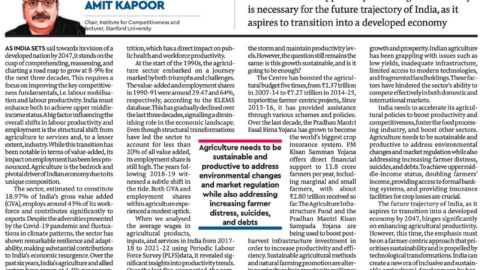Leveraging human capital is a fascinating topic for developing societies. It is because social and economic progress is critically dependent on it. Most observers point out that India possesses a distinct demographic dividend. The dividend will only fructify into tangible gains if appropriate policies and structural mechanisms are put in place.
At present approximately a million young people are entering the workforce each month. The challenge is to help them contribute to the economic development of the country. These youth entering the workforce over the next ten years have the potential to make or mar the prospects of India’s growth story.
There are four essential parts to the realization of the demographic dividend that India possesses at present. These are skilling, entrepreneurship, proactive approach to youth affairs and employment generation.
Skilling is crucial, as there exists a gap between what students are being taught and what the industry requirements are from professionals. The skill gap is responsible for a large section being unemployed and unemployable. The issue of employability can only be solved when the curricula takes the industry needs into account.
Vocational education, as well as skilling for students who drop out of school early is one of the best ways of ensuring a means of livelihood and movement out of poverty. The ministry of skill development and entrepreneurship was created by bringing together all the skill development initiatives of the government under a single roof. The central ministries/departments have done a good job so far in the area and have trained around 58 lakh people in 2014-15.
Related to skilling is entrepreneurship. The fact of the matter is that providing employment to a million people/month is simply an unachievable target for the government working on its own. Therefore, an imperative for employment generation and labour market development in India is entrepreneurship. The government realizes this and thus has created the above-mentioned ministry. So far India has not fared very well with respect to entrepreneurship. The formal creation of firms in India is low and cumulatively smaller than much smaller places like Hong Kong if one observes World Bank data from 2004-11.
There are many social, cultural and economic reasons for this. Risk aversion in society, very high costs of failure and lack of access to funding are some of the prominent reasons for the India’s low scores on most international indices of entrepreneurship. An access to venture funding and changing the mindset of people in society will go a long way in promoting entrepreneurship and helping energize the youth for national development.
Recent years have also witnessed the phenomenon of brain drain where talent from India is leaving the country as people look for greener pastures abroad. The trend can only be abated or reversed if the incentive structures within the country are changed and proper means of engagement are built with the diaspora abroad.
Successive governments have failed to do so and this is where youth diplomacy can play an active role in engaging with not only our diaspora but with youth from across the world. India is a young nation and can grow immensely by exchange of ideas at a youth to youth level. Energizing and channelizing the collective energy of the Indian youth will only strengthen the cause of nation building and development.
Finally, there is the issue of employment generation. That can be achieved if only there are appropriate incentives for enterprises across sectors to flourish. Added to this is the fact that further liberalization of foreign direct investment (FDI) norms and industrial policy could enable greater capital inflows that can aid in industrial and economic development. The present regime has moved in the right direction in this regard but much bolder steps are required especially in opening up more sectors to foreign direct investment.
The recently released quarterly survey of employment October-December 2014 shows that 1.17 lakh jobs were created in the eight key sectors for which the survey was conducted. This was lower than the 1.58 Lakhs created in the previous quarter. Also, if one compares the data from July to December 2014, one observes that there were 2.75 lakh jobs that were created compared to 1.26 lakh jobs a year ago. That’s an increase of 118 percent rise for the six-month period year-on-year. The surge was lead by the IT and BPO sector that added 89,000 jobs in the October-December 2014 quarter. It was followed by the textiles and apparel segment that added 79,000 jobs.
One of the major planks on which the present government won the 2014 general elections was job creation. On this count, the government seems to be doing well. However, one must realize that this is a limited survey of just eight sectors. Also, the growth in employment seems to be concentrated in the IT and textiles & apparel sector. Broad- basing the survey to other sectors as well as broad-basing of jobs created will go a long way in ensuring that trends are observed and appropriate policy actions taken. The chief statistician recently has alluded to better data collection on the employment front. Considering the importance of this in policy analysis and action on this is indeed is a welcome step for a more informed debate on the Indian economy.
Over the next few years, the government will have to focus continuously on these critical areas for growth to be broad-based and inclusive. At present, the trends from the limited data seem positive but these areas require better data and scrutiny over the next decade.
Published with Business Standard on June 8, 2015.
























